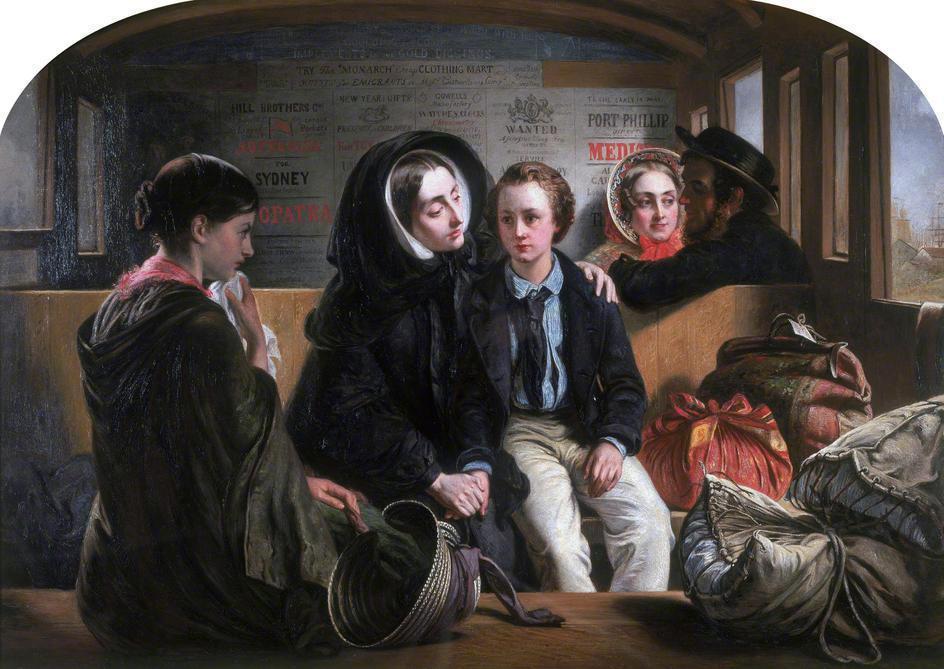
English Artists: The Solomons (mid-19th century)
Abraham (1824-62)
Abraham Solomon was born in London (1824). He learned painting formally at the Bloomsbury School. He was admitted to the Royal Academy. He began painting at about the same time photography was invented. Abraham became a successful English Victorian artistv known for depicting contemporary social scenes and other genre work. His works provide insights into Victorian life that photography was not capable of producing. 'The Acolyte' was an early work (1842). It shows a boy, perhaps an early Christian, wearing liturgical vestments, swinging a thurible.
'Second Class, The Parting' (1854) shows us what second-class rail travel was like in the early-1850s (figure 1). Note the open carriage. But besides this we are presented a tragic image of a young boy described by one art scholar as emigrating to Australia. His mother and sister are traveling with him on the way to his port of embarkation, perhaps Liverpool or Portsmouth. His mother and sister fear they will never see him again. We are not sure that this is accurate. We are not at all sure that boys this age migrated to Australia. Rather it is more likely he is going to sea as an apprentice sailor/cabin boy, perhaps on a ship headed to Australia. Note the commercial advertisement for Sydney and sailor in the background. We see the scene as maudlin today, but a Victorian mother would have beem moved. One of the social issues addressed by Abraham was inequities in the British legal system. 'The Acquittal' (1857) was one of these legal or court-related images. Abrham paints an exhausted family who had waited in court an entire day learn that their relative, perhaps father or son, had been judged not guilty of an unspecified crimne. Their relief, although overstated as was common in Vicrorian art, was clearly heartfelt. The legal system could be quite harsh with working class Victorians. One art analist writes, "... as the gap between the haves and the have-nots widened to a chasm. For the upper classes in England, graphic content like Abraham painted was largely invisible." This is not entirely accurate. The Industrial Revolution did obviously create inquyities and firtunes were made while the working class struggled. But to think that inquities did not exist before the Industrial Revolution or that the the working-class lived a idelic, bucolic life is absured. Many of his genre works, even the highly emotive ones, images have a comedic touch or comedic elements. Abraham died at a relatively young age, limiting his boy of work.
Rebecca (1832-86)
Abraham'sister Rebecca was also a notable genre artist. Women were not admitted ti art schools at the time. So Abraham taught his younger sister. She was a rare woman artist allowed to exhibit her paintings at the Royal Academy which she often did between 1851-75. She created some remarkable images, but her work is not well covered by art historians. Children are commonly pictured in these genre scenes, especially those by Rebecca who added a woman's perspective. 'The Governess' (1854) is one of her early paintings. It is a kind of split image. The ell off mistress and master of the house gaze with affection at each other. The younf woman had mnarried well nd leads a comfortable life. The other half of the image is another genteel young lady. She is attractive, but with out family money and has not succeded in attracting a suitor. There were at the time vey limited career opportunities for genteel young women. One was to be a governess and live in the house of a propsperous family to care for their children. The governess can only imagine the family that might have been had she found a husband. Abnd as a governess, the chances of doing so steadily declined as she grew older. Rebecca was not a member of the Pre-Raphaelite movement. She moved in important artistic circles. She was an assistant in the studio of John Everett Millais. And for a time worked for Edward Burne-Jones as a model. Rebecca made transitioned to to classical and historical themes (late-1850s), a more respected subject matter during the Vicyorian era. She like her older brother was also snatched from the art world at a reltuively young age. She was run over by a coach (1886).
Simeon (1840-1905)
Simeon Solomon was born in Lonson (1840). His older brother abraham gave him art lessons (about 1850). He entered Carey's Art Academy (1852). Simeon He became a fixture in the Pre-Raphaelite aesthetic movement. He was obviouslu talented, At a young age he met and become intimate with Dante Gabriel Rossetti and Edward Burne-Jones. They then introduced their new friend to William Holman-Hunt, Algernon Charles Swinburne and other members of the London intellectual elite. Two of Simeon's dreamy paintings 'The Sleepers and the One Who Watcheth' and 'A Prelude by Bach' are instantly recognizable as Pre-Raphalite works having no relpationship tp the realistic if maudeling genre works of his brother amd sister. Simeonís notable rise and then tragic fall has been well documented by art historians. His works are not of great interest to HBC, but are of some interest to art historians because of the imprtance of the pre-Rahaelite movement. Simeon as a result of of charges for indecent exposure and sodomy was oustracized from fashionable circles.
HBC
[Return to the Main English art page]
[Introduction] [Activities] [Biographies] [Chronology] [Cloth and textiles] [Clothing styles] [Countries] [Topics]
[Bibliographies] [Contributions] [FAQs] [Glossaries] [Images] [Links] [Registration] [Tools]
[Boys' Clothing Home]
Created: 11:41 AM 9/14/2013
Last updated: 11:41 AM 9/14/2013


